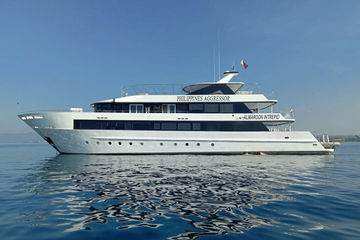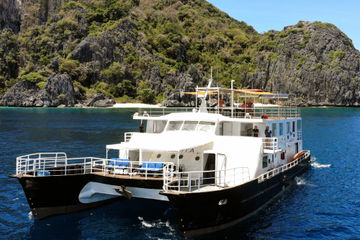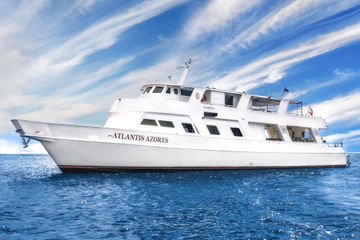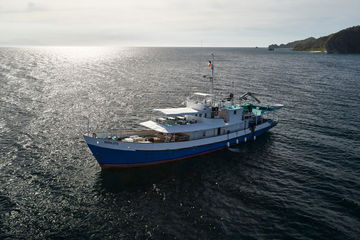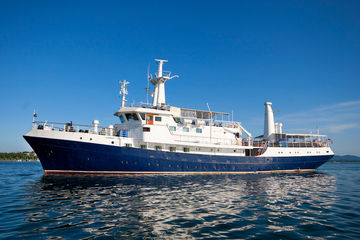Diving in the Philippines
The best way to experience Philippines scuba diving is by liveaboard with over 7000 islands to explore, many completely untouched. This is a great place to see thresher sharks, dugongs and other macro life amongst the wrecks walls and coral beds. The Tubbataha World Heritage Site offers a plethora of unique creatures.
Scuba diving in the Philippines means the opportunity to explore and area of more than 7000 islands with white sandy beaches crystal clear turquoise waters and extremely thriving marine environments. With dive sites including wrecks, sea walls, incredible coral beds and in addition many large pelagics to see; going on dive trips in the Philippines will guarantee many breathtaking moments.
Philippines diving is possible to dive here all year round and there are opportunities for every level of diving experience and for anyone more comfortable on land there are islands with stunning beaches, waterfalls to swim in and jungles to explore; something for everyone.
13 Liveaboards in PhilippinesExplore all liveaboards
Diving in the Philippines FAQ
What marine life can I expect to see in the Philippines?
There is such a large diversity and variety of marine life in the oceans of the Philippines and this all originates from the incredibly rich jungle of corals which grow from these sea beds, this attracts species of all kinds. Some of the most unique species which are present here include the gentle giants that are Dugongs, aka Sea Cows which is an endangered species but thriving in this area. There are also Thresher sharks with their extended tails and adorable faces, six out of seven species of sea turtles, the unique Napoleon Wrasse, the tiny but special pygmy seahorses and one of the main spectacles of this area; the Whale Sharks. These species are accompanied by large schools of reef fish, large and colourful sponges and endless macro life.
What are the best dive sites in the Philippines?
TUBBATAHA - Scuba diving in a world Heritage Site seems almost like a dream, but in the Philippines, this is possible in the Tubbataha Reef National Park and what makes it even better is that it is considered one of the best dive sites in the world. Planning a dive trip at this dive spot will have to be with a liveaboard as that is the only way to access it; the benefits of this is fewer divers, a better preserved environment and more wildlife. The wildlife here includes tiny creatures of the sea with their colours and unique shapes and sizes, the utterly graceful turtles, a thriving reef and even larger species such as Hammerhead sharks; now imagine all of this in crystal clear, turquoise waters, a truly special scuba diving experience.
APO ISLAND - A small island with a big variety of gorgeous underwater spectacles for divers of all levels. Known for its excellent visibility almost year round, when scuba diving at Apo Island you will see many species of soft and hard corals, run into some turtles, bumphead wrasses and large schools of fish swimming through the may bubbles which come up from the volcanic ground on the sea bed; another element which makes this dive even more special. Dive sites are range from 20m - 25m (60ft - 75ft) and with different levels of difficulty. There are sea walls you can see, drift dives, marine sanctuaries and large species such as Manta rays, whale sharks, Reef sharks and Devil rays.
VISAYAS - The Visayas is an extremely popular scuba diving location in the Philippines as it is known to be the place where you can see the absolute best of this countries underwater wonders in just one dive area. They are a group of islands, in the central area of the Philippines, which hold all the beauty underwater. It begins with the smaller macro life of which there is a lot in all shapes, sizes and colours but fear not, the size of the marine life increases up to the spectacular whale sharks, thresher sharks and more pelagics.
MALAPASCUA - Malapascua is an island located off the north of Cebu and is most well known for having the most reliable sightings of the Thresher sharks, an extremely graceful species of shark. Alongside them fly some beautiful Manta Rays and Eagle Rays. This dive area provides divers with sea wall dives, underwater islands, caves, a marine reserve, the elusive and unique mandarin fish and a diverse selection of colourful colours and marine species.
What's the best time to dive in the Philippines?
SEASONS AND CONDITIONS: It is absolutely possible to dive all year round in the Philippines, but each season is a different experience. The absolute best time to plan a scuba diving trip in the Philippines is during the dry season which stretches from March to June. It brings warm, dry and calm weather and fantastic visibility. From September to December it is typhoon seasons which can affect diving conditions. There is a large variation in visibility; it ranges from 5m - 45m (16ft- 148ft) completely depending on the time of the year.
WATER TEMPERATURE: The temperature of the water also varies, but is always at a pleasant temperature. The temperature at its lowest is 23 C (73 F) and heats up to 30 C (86 F), all for which you only need a westsuit, and in the dry season with the warmest water temperatures a shorty wetsuit will suffice, or even no wetsuit!
What's the recommended experience level for diving in the Philippines?
Scuba diving in the Philippines means seeing some of the best dive spots in the world, and it is possible for everyone of any level of diving. There are numerous dive sites in each dive area and each with their own level of difficulty. In general, it is very beneficial for you if you have your Open Water Certification and for some dives including wreck dives a further certification is needed.
How do I get to the Philippines?
The main entrance port into the Philippines coming from international destinations is Cebu City, one of the largest cities in the Philippines. The international airport here is called Mactan-Cebu International Airport and receives flights from Manila, other south East Asian destinations and Dubai, there are also other international flights that arrive here but always through a transfer in a neighbouring country. If you have signed up for a Philippines liveaboard trip, then they will depart from the port of Cebu City. Cebu itself has an array of waterfalls and jungles for you to go and explore during your time there, for some on-land adventures!
The other city into which you can fly to reach some of the dive sites is Puerto Princesa which is Palawan's capital. The airport is named Puerto Princesa International Airport, but for passenger flights, they only fly to Cebu and Manila. If you are planning to take a liveaboard to the Tubbataha National Park then it will depart from the port of Puerto Princesa. There are multiple activities in and around Puerto Princesa for visitors to enjoy including exploring its flourishing jungles, visit the Puerto Princesa Underground River and even do some island hopping.
